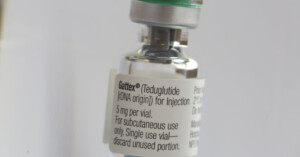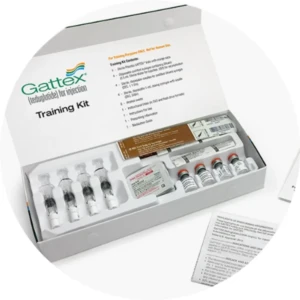Medical Advise Disclaimer:
This information is provided for general informational purposes only and is not intended as, and should not be considered a substitute for, professional medical advice. Do not use the information on this website for diagnosing or treating any medical or health condition. If you have or suspect you have a medical problem, promptly contact your professional healthcare provider. Always seek the advice of your physician or other qualified health provider with any questions you may have regarding a medical condition. Never disregard professional medical advice or delay in seeking it because of something you have read on this website.
GATTEX® (Teduglutide)

What is GATTEX
Gattex (teduglutide) is a medication used to treat short bowel syndrome (SBS) in adults and children who are dependent on parenteral nutrition. Short bowel syndrome is a condition in which the small intestine is unable to absorb enough nutrients and fluids to sustain the body, often resulting from surgical removal of a significant portion of the small intestine.
Here are some key points about Gattex:
- Mechanism of Action: Gattex is a glucagon-like peptide-2 (GLP-2) analog. GLP-2 is a naturally occurring hormone that plays a role in the maintenance and repair of the lining of the intestines. Gattex works by mimicking the actions of GLP-2, promoting intestinal growth and increasing the absorption of nutrients.
- Indication: Gattex is indicated for the treatment of adults and pediatric patients 1 year of age and older with short bowel syndrome who are dependent on parenteral support.
- Administration: It is administered by subcutaneous injection once daily. The dosage is determined based on body weight.
- Clinical Trials: The approval of Gattex was supported by clinical trials that demonstrated its ability to reduce the need for parenteral support and increase intestinal absorption of nutrients in patients with short bowel syndrome.
- Side Effects: Common side effects of Gattex may include abdominal pain, injection site reactions, nausea, headaches, and upper respiratory tract infections. Serious side effects may include gastrointestinal perforation.
- Monitoring: Patients taking Gattex may require regular monitoring, including assessments of fluid and electrolyte balance, liver function, and the development of any gastrointestinal symptoms.
- Pregnancy and Breastfeeding: It is important to inform healthcare providers if you are pregnant or breastfeeding, as the safety of Gattex during pregnancy and lactation has not been established.
- Interactions: Patients should inform their healthcare providers about all medications, including over-the-counter and herbal supplements, as there may be potential interactions.
It’s crucial to note that this information is a general overview, and specific details may vary. Patients should always follow the guidance and instructions provided by their healthcare professionals. If you have any specific questions or concerns about Gattex, it’s recommended to consult with a healthcare provider for personalized information.
History of GATTEX
Here is a brief history of Gattex:
- Development and Approval:
- Gattex was developed by NPS Pharmaceuticals (now a part of Shire, a Takeda company).
- The drug went through clinical trials to evaluate its safety and efficacy in treating short bowel syndrome.
- FDA Approval:
- Gattex received approval from the U.S. Food and Drug Administration (FDA) on December 21, 2012.
- The approval was based on studies demonstrating that Gattex increased the absorption of fluids and nutrients in patients with short bowel syndrome.
- Mechanism of Action:
- Gattex is a glucagon-like peptide-2 (GLP-2) analog. GLP-2 is a naturally occurring hormone in the body that stimulates the growth and repair of the intestinal lining.
- By mimicking the action of GLP-2, Gattex helps to improve the absorption of nutrients and reduce dependence on parenteral support.
- Clinical Use:
- Gattex is administered as a subcutaneous injection (under the skin).
- It is used in conjunction with a specialized diet and other supportive measures to manage short bowel syndrome.
- Subsequent Developments:
- Gattex has been subject to ongoing research and clinical studies to further understand its long-term safety and effectiveness.
- As with any medication, there may be updates, modifications, or additional indications over time.
It’s important to note that the information provided is based on my knowledge as of January 2022, and there may have been developments or updates since then. If you are seeking the latest information, it’s recommended to consult medical professionals, official prescribing information, or recent medical literature.
Starting GATTEX
Complete the Start Form or talk with your intestinal care provider. A good way to start the conversation about starting GATTEX is to download the Conversation Guide provided by GATTEX.
OnePath

When GATTEX is prescribed for you, OnePath’s committed support is available to assist you. Upon joining OnePath, you will be linked with a dedicated specialist who will be your main point of contact. They will handle your queries and address any concerns, guiding you through the next steps. Whether providing information directly or connecting you with the appropriate person, our aim is to facilitate your journey in accessing your GATTEX treatment, making the process a bit smoother for you.
Administration of GATTEX
Possible Benefits of GATTEX
GATTEX, or teduglutide, has several benefits in the management of SBS:
- Increased Intestinal Absorption: GATTEX helps improve the absorption of nutrients, including fluids and electrolytes, in the remaining portion of the small intestine. This can reduce the dependence on parenteral nutrition (nutrition delivered intravenously).
- Reduction in Parenteral Nutrition Dependence: One of the primary benefits is a reduction in the need for parenteral nutrition. By enhancing intestinal absorption, GATTEX can contribute to a more normal diet, allowing individuals with SBS to rely less on intravenous nutrition.
- Improved Quality of Life: With a decreased reliance on parenteral nutrition and improved nutrient absorption, individuals with SBS may experience an improvement in their overall quality of life. This includes increased energy levels and a reduction in complications related to malnutrition.
- Maintenance of Fluid and Electrolyte Balance: GATTEX helps in maintaining a better balance of fluids and electrolytes in the body, addressing issues related to dehydration and electrolyte imbalances often seen in SBS patients.
- Potential for Intestinal Adaptation: Long-term use of GATTEX may lead to intestinal adaptation, where the remaining portion of the small intestine becomes more efficient in absorbing nutrients over time.
Possible Side Effects of GATTEX
GATTEX is a medication that may have serious side effects, including the potential to stimulate the growth of abnormal cells, increasing the risk of cancer in the bowel, liver, gallbladder, or pancreas. It can also lead to the development of polyps in the colon, requiring regular checks and removal. Bowel blockage, inflammation, or blockage of the gallbladder or pancreas are possible complications. Regular tests are recommended to monitor these issues. Fluid overload may occur, leading to heart failure, especially in individuals with heart problems. Common side effects in adults include abdominal pain, nausea, flu-like symptoms, skin reactions at the injection site, vomiting, and swelling of hands or feet. Similar side effects are observed in children and adolescents. Prior to using GATTEX, individuals should inform their healthcare provider of their medical history, including cancer, polyps, heart problems, high blood pressure, and issues with gallbladder, pancreas, or kidneys. Pregnancy and breastfeeding considerations are also important, with unknown effects on unborn babies and the recommendation to avoid breastfeeding during GATTEX treatment. Any persistent or bothersome side effects should be reported to the healthcare provider.


 The administration method of GATTEX involves subcutaneous injection. The injections are given daily and can be administered by the patient or a caregiver after proper training.
The administration method of GATTEX involves subcutaneous injection. The injections are given daily and can be administered by the patient or a caregiver after proper training.